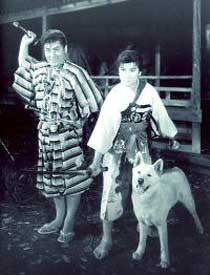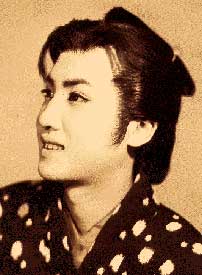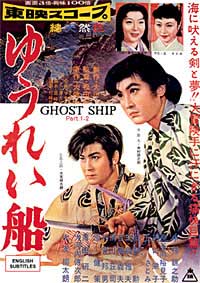Ghost Ship (Yurei-sen, Toei, 1957) is a double-film based on a novel by Jiro Osaragi (1897-1973) who also created the Kurama Tengu character, a sort of Japanese equivalent of the Lone Ranger, featured in a great many films.
Because of the title Ghost Ship, this film has found its way onto lists of horror films & ghost stories, though it is nothing of the sort. The two parts taken together form a lengthy children's film, shot in a highly pictorial style widescreen color, with its heros & villains by & large detectable by who smiles & who doesn't.
There is a token scene of spookiness in each of the two parts, a fake demon in Part I, a weird dream in Part II. There is nothing supernatural nor horrific about either part, although the secret island community encountered in Part II comes close to qualifying Ghost Ship as a fantasy.
 As Part I opens, Jubei (Ryunosuke Tsukigata), the best of sea skippers, is unable to overcome the stormy seas of Luzon. All hands on board the Kannonmaru were lost except for Shinkei, who alone made his way to land & eventually home to inform his grandson Jiromaru (Kinnosuke Nakamura) that his father Jubei met with disaster. As Part I opens, Jubei (Ryunosuke Tsukigata), the best of sea skippers, is unable to overcome the stormy seas of Luzon. All hands on board the Kannonmaru were lost except for Shinkei, who alone made his way to land & eventually home to inform his grandson Jiromaru (Kinnosuke Nakamura) that his father Jubei met with disaster.
Young Jirumaru, standing prettily on an outcropping overlooking the sea, selects this moment to tell his grampa he doesn't want to be a skipper like his dad, but wants to go to Kyoto & become a samurai.
He & his cute white akita hound, which never has anything whatsoever to do in the story but is cute to look at, head off to Kyoto without the white dog getting even a little dirty & without Jirumaru's colorful pale kimono ever looking like it needs pressing.
In Kyoto, the naive youngster meets sundry nice people who live outside the law. Foremost among the people he meets is Samonosuke (Ryutaro Otomo), a ronin who had formerly been a lord but now lives a wanderer's life & would be killed if the shogun's minions ever got hold of him.
The Ashikage shogunate has reduced the city to starvation & ruin due to the misrule of Matsunaga Danjo. Princess Yuki Miyoshi with her attendand Chacha (Yumiko Hasegawa & Hiroko Sakuramachi) are in hiding, coming & going by an underground passage through a ruined mansion disguised with oni-devil masks so that locals will believe the ruins are haunted & not catch on the princess hides there.
She & Chacha are also attempting to help the suffering people, not something she's very successful at doing & the whole idea of helping commoners will evaporate from the epic once it moves on to the second-film half of the adventure.
Our young hero has an uncle in Kyoto, a successful merchant who is on good terms with the evil shogun. His uncle's son Saemontaro is an obnoxious cruel selfish fellow who doesn't want his goody-two-shoes cousin hanging around & is abusive to everyone.
It slowly dawns on Jiromaru that his uncle & cousin, like the shogun, are bad men, & the people he met earlier who are outlaws are much kinder & more decent. When his uncle jests about the shogun's current plan to capture Princess Yuki, it's too much for Jirumaru to take, & he runs off with his doggy to warn the princess.
As things develop, Samonosuke & Jiromaru must rescue the princess from shogunate soldiers. They then escape by sea. As Part I is ending, the fleeing group of good-guys spot a ghost ship which is none other than the Kannonmaru, the ship of Jiromaru's father, too far out in the ocean to catch up to.
 Part II opens on an eerie scene of Jiromaru investigating the drifting ghost ship, with Kannon the Goddess of Mercy the figurehead at the prow. He runs along the deck calling for his father, then investigates the flooded hold. Though unnoticed at first, he realizes there are corpses & skeletons in the hold, & he flees back to the deck, where all his companions of recent adventures lay slain. Part II opens on an eerie scene of Jiromaru investigating the drifting ghost ship, with Kannon the Goddess of Mercy the figurehead at the prow. He runs along the deck calling for his father, then investigates the flooded hold. Though unnoticed at first, he realizes there are corpses & skeletons in the hold, & he flees back to the deck, where all his companions of recent adventures lay slain.
Awakening at his grandpa's house with his companions watching over him, he realizes he has had a fever-dream, & he never was on board the ghost ship Kannonmaru.
Princess Yuki & Chacha are soon kidnapped by pirates. The pirates also happen to kill our young hero's obnoxious cousin from Part I, which is about the only connecting thread that links Part I events to Part II events, though Jiromaru never finds out about it & his cousin's murder impacts the central character not one whit.
Jiromaru of course is eager to rescue the brave but hapless princess & her maid a second time. Having found his pursuit of samuraihood to be foolish indeed, he accepts his grandfather's request that he become the skipper of a new ship. All the good guys set out to sea in search of those mean & nasty pirates who, despite having gone someplace very secret, will be quickly tracked own.
The pirates would've raped the women, but figured they'd both commit suicide if they were violented. If they killed themselves that would make it hard to get a big ransom for them, not that they seem to have any ideas who'd pay a ransom & they never actually seek one.
Because of an unpleasant run-in between the pirate ship & the ghost ship, the head pirate is obsessed with tracking down the ghost ship & getting revenge.
The pirates find their way to Ghost Island which appears to be unreachable by ships because of looming cliffs & treacherous reefs. But there's a secret way into a cove at the heart of the island, where there is a colony of peaceniks who've chosen to live in this secluded place lorded over by a benevolent ex-pirate dictator who in his old age is trying to make amends for his former life of piracy.
The old ex-pirate likes to dress up like a children's-book fairy king, which is one way we know he's a good guy, since only the good guys smile & wear bright clothes. He happens to have saved Jubei during the storm when all hands were lost except the captain, & he even got the Kannonmaru sailing again, using it instead of his own ship to harry evil pirates & build up the legend of a ghost ship.
When the pirates show up it's pretty easy for them to take over, the colonists being so peaceable & all. But they didn't count on the benevolent dictator having rigged the island with explosives so that he could destroy the whole place any time he wanted. Getting the colonists to the only place not wired with explosives on the pretext of instructing them to obey the pirates, all the bad guys are blown up & all the good guys except the ex-pirate who threw the switch are saved.
In the cove of the ruined island are four ships, the Kannonmaru, the ship of the ex-pirate dicatator, the pirates' ship, & a ship the pirates took from Jirumaru's cousin. The good colonists, finding their island blown up around them, get on these four ships & set off to search for another island where they can live secretly, "never again to return to Japan."
Never seeing Japan again is treated as a happy ending, which is pretty damned silly. But oddly enough such small island colonies of Japanese smugglers did exist, whose economy was based on being go-betweens for illegal trade with China. And that's exactly what supported the ex-pirate's medieval hippy commune, who despite their peacenik ways were actually arms dealers (for which, strangely enough, no irony is intended).
Sometimes the most childish of children's stories has some real history to them, & Japanese smuggler colonies are the historicity that underlies this rank fiction.
The film is overall insignificant. Kinnosuke is one of my favorite actors but he's a complete wuss in this story & dresses in kimono so fancy he seems like a wakashu catamite rather than a kid from a small port town. Ryutaro Otomo steals the film with his mighty & fatherly presence, & almost makes his smiley-sweet role believable. It's definitely a children's film, a little too simplistic & absurd for adult interest.
copyright © by Paghat the Ratgirl
|


